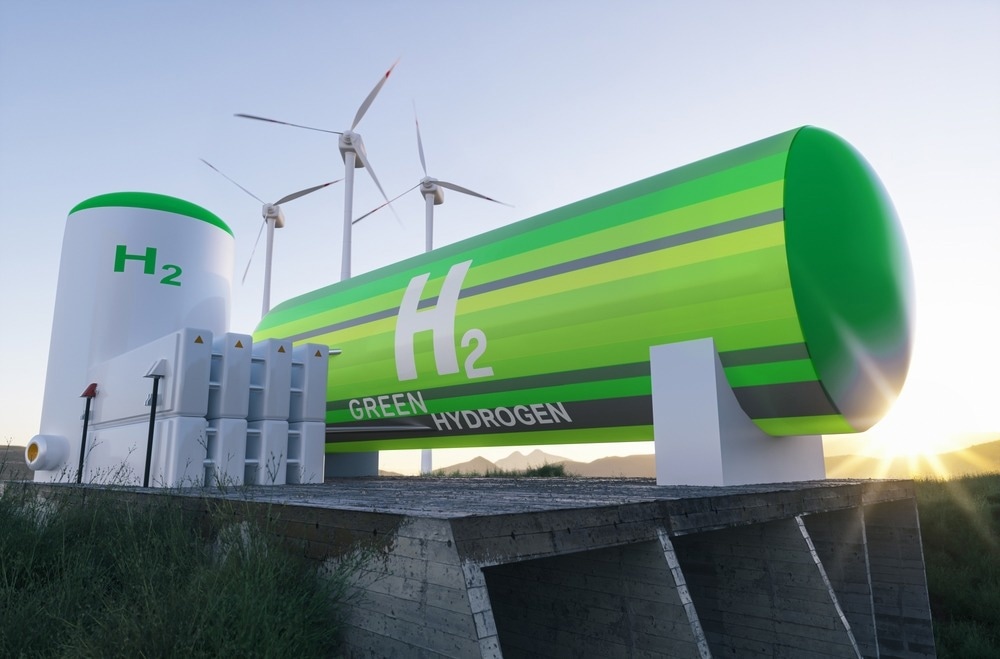Reviewed by Mila PereraSep 9 2022
Green hydrogen from renewable electricity and synthetic e-fuels are exclusively valuable for realizing climate neutrality. They can substitute fossil fuels in long-distance conveyance or industry where direct electrification is not practical.

Image Credit: Shutterstock.com/Audio und werbung
However, even if the manufacturing capacities increase as rapidly as the growth-rate leaders, solar and wind power, green hydrogen supply is still scarce in the short-term and undetermined in the long term, as a new study reported in the journal Nature Energy reveals.
Green hydrogen would probably supply below 1% of total energy worldwide by 2035, while the European Union (EU) might reach the 1% mark slightly earlier by around 2030. Notably, the EU’s 2030 scheme to deliver 10 million tons of green hydrogen with domestic capacity will be unattainable unless policymakers can promote unparalleled growth for energy technologies.
By 2040, an advance to higher green hydrogen shares is more probable; however, huge reservations still prevail, which increases present-day investment hazards. However, history demonstrates that crisis-like policy measures could bring considerably higher growth rates, accelerating the advance and boosting the probability of future hydrogen availability.
It has stimulated a flood of enthusiasm in the recent past and plays a fundamental role in enabling several net-zero emissions set-ups: green hydrogen and derived e-fuels rely on renewable electricity and are created via a process known as electrolysis, separating water molecules H2O into hydrogen and oxygen.
Much of the debate and research around hydrogen has revolved around demand-related questions of suitable applications, markets, and sectors. But so far no study analyzed the bottleneck of possible expansion pathways for electrolysis - a supply technology in its infancy that needs to experience rapid innovation and deployment to unleash its potential for climate change mitigation.
Adrian Odenweller, Study Lead Author, Potsdam Institute for Climate Impact Research
A Breakthrough for Green Hydrogen Is Not a Given — Decisive Policy Action Is Required
Present-day electrolyzers are typically small and independently produced; however, global capacity needs to increase 6000-8000 fold by 2050 to support climate neutrality scenarios matching the Paris Agreement. This overshadows the mandatory 10-fold increase in renewable power, which is readily available and low cost.
Employing an energy technology diffusion computer simulation involving thousands of possible worlds, the scientists took a plunge into the probability and viability of boosting electrolysis capacities.
The broad success of green hydrogen is not at all a given. Even with electrolysis capacities growing as fast as wind and solar power, there is strong evidence of short-term scarcity and long-term uncertainty in terms of green hydrogen availability. Both impede investment in hydrogen end-uses and infrastructure, reducing green hydrogen’s potential and jeopardizing climate targets.
Falko Ueckerdt, Study Co-Author, Potsdam Institute for Climate Impact Research
“Nonetheless, while this might make green hydrogen a risky bet from a policy perspective, historic analogs also suggest that emergency-like policy measures could foster substantially higher growth rates, expediting the breakthrough and increasing the likelihood of future hydrogen availability,” Falko Ueckerdt added.
These analogs include circumstances of wartime mobilization (e.g., liberty ships or US aircraft in World War II), huge public investments, central coordination (e.g., high-speed rail in China or nuclear power in France), or market-motivated deployment of extremely modular IT innovations with low coordination necessities (e.g., smartphones or internet hosts).
Investing Political Capital with Growing Knowledge and Balancing Remaining Risks
The authors state that knowledge concerning hydrogen, covering everything from availability to costs, will grow exponentially in the upcoming years. Nurturing rapid investments into green hydrogen supply chains that allow exceptionally high growth rates of electrolysis would widen the viability space surpassing what has been experienced for energy analogs such as solar and wind.
This could break the vicious cycle of uncertain supply, insufficient demand, and incomplete infrastructure, and turn it into a positive feedback mechanism, in which each component bolsters the others. Short-term scarcity and long-term uncertainty are two sides of the same coin and could be resolved together through stronger policy support that engenders shared expectations of rapid growth,
Gregory Nemet, Study Co-Author, University of Wisconsin-Madison
Policies that jump-start a quick deployment of electrolyzers supplying Gigawatt-scale capacities could soon assist in unlocking considerable innovation and scaling effects and enable green hydrogen to match the demand in sectors that are remote to direct electrification, according to the study.
Along with increasing renewable electricity, it could present hydrogen with the opportunity to attain a wider and more leading role in a climate-neutral energy platform.
However, policymakers should keep in mind that there still is a risk of inflating green hydrogen’s potential.
Even under favourable developments for the foreseeable future, hydrogen supply will be much too scarce to substitute fossil fuel use on a broad scale. Policymakers should prioritize hydrogen incentives in sectors where no other alternatives exist, such as heavy industry (e.g., steel), or power supply in hours of low wind and solar electricity generation.
Gunnar Luderer, Study Co-Author, Potsdam Institute for Climate Impact Research
Hydrogen, however, should not be used as an excuse to postpone the roll-out of other readily available clean options such as heat pumps or electric mobility. To successfully decrease greenhouse gas emissions and curb climate risks, all essential zero-carbon technologies must be enthusiastically expanded.
Journal Reference:
Odenweller, A., et al. (2022) Probabilistic feasibility space of scaling up green hydrogen supply. Nature Energy. doi.org/ 10.1038/s41560-022-01097-4.